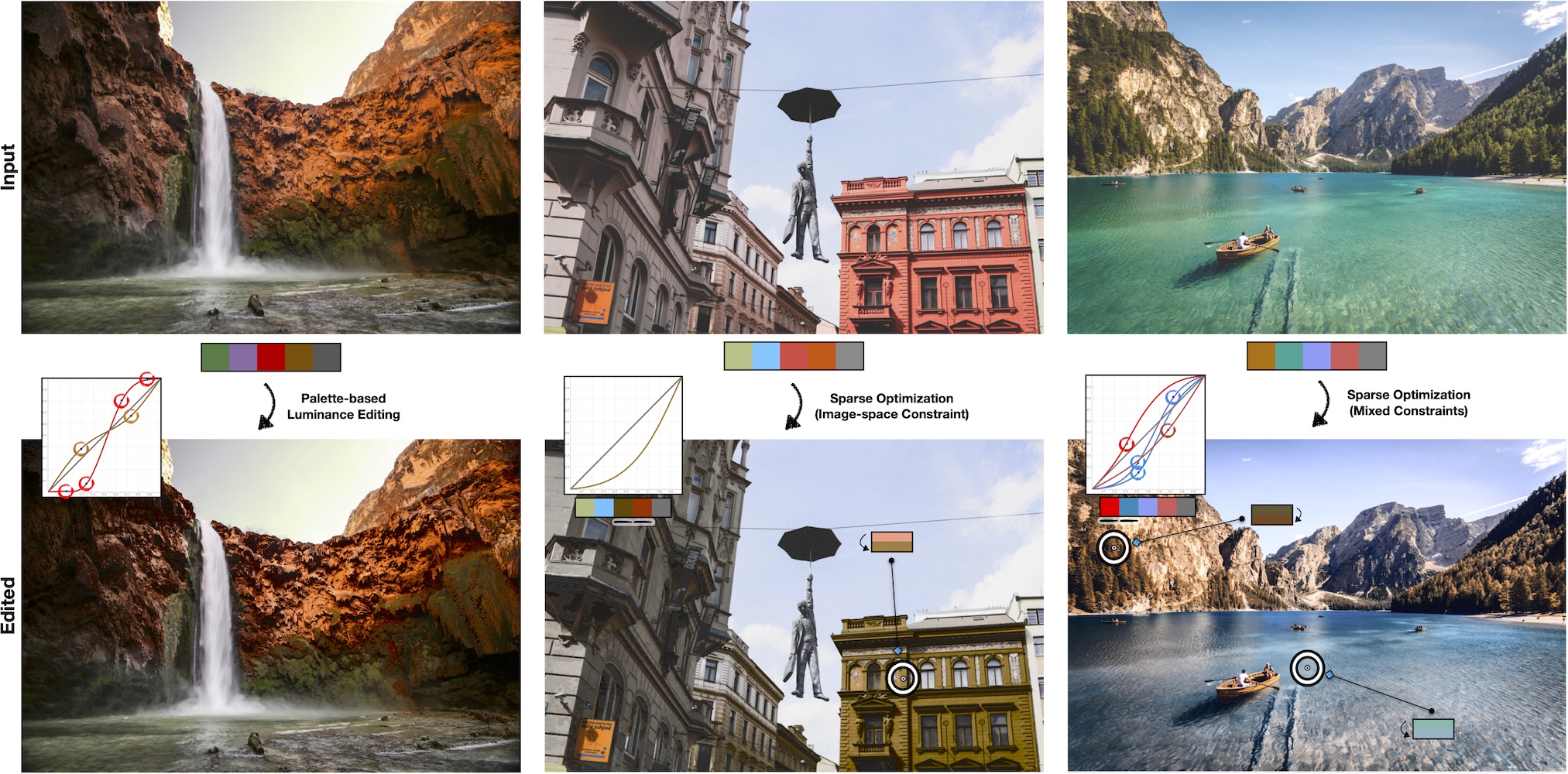ColorfulCurves: Palette-Aware Lightness Control and Color Editing via Sparse Optimization
Paper
Presentation
Code
User Study Data
 ColorfulCurves extracts a hue-chroma palette and builds palette-based tone curves to allow sparse, per-palette-color control of lightness over the image. Users place constraints on palette colors, tone curves, or directly on image pixels. ColorfulCurves optimizes the palette colors and lightness curves to satisfy the user’s constraints. Left: The user adds contrast to the rocks with S-shaped curve constraints on the red and brown colors. Center: The user places an image-space constraint on the building to make it dark brown. ColorfulCurves optimizes for the sparsest satisfying change to the palette. Right: The user places a mix of image-space, palette, and curve constraints. Photos courtesy of (left to right) Jeremy Bishop, Nastya Dulhiier, and Pietro De Grandi.
ColorfulCurves extracts a hue-chroma palette and builds palette-based tone curves to allow sparse, per-palette-color control of lightness over the image. Users place constraints on palette colors, tone curves, or directly on image pixels. ColorfulCurves optimizes the palette colors and lightness curves to satisfy the user’s constraints. Left: The user adds contrast to the rocks with S-shaped curve constraints on the red and brown colors. Center: The user places an image-space constraint on the building to make it dark brown. ColorfulCurves optimizes for the sparsest satisfying change to the palette. Right: The user places a mix of image-space, palette, and curve constraints. Photos courtesy of (left to right) Jeremy Bishop, Nastya Dulhiier, and Pietro De Grandi.
Abstract
Color editing in images often consists of two main tasks: changing hue and saturation, and editing lightness or tone curves. State-of-the-art palette-based recoloring approaches entangle these two tasks. A user’s only lightness control is changing the lightness of individual palette colors. This is inferior to state-of-the-art commercial software, where lightness editing is based on flexible tone curves that remap lightness. However, tone curves are only provided globally or per color channel (e.g., RGB). They are unrelated to the image content. Neither tone curves nor palette-based approaches support direct image-space edits—changing a specific pixel to a desired hue, saturation, and lightness. ColorfulCurves solves both of these problems by uniting palette-based and tone curve editing. In ColorfulCurves, users directly edit palette colors’ hue and saturation, per-palette tone curves, or image pixels (hue, saturation, and lightness). ColorfulCurves solves an L_2,1 optimization problem in real-time to find a sparse edit that satisfies all user constraints. Our expert study found overwhelming support for ColorfulCurves over experts’ preferred tools.
Fast Forward (20 seconds)
Download as:
Video Demonstration (4:30 minutes)
Download as:
BibTeX
@article{Chao:2023:CC,
author = {Chao, Cheng-Kang Ted and Klein, Jason and Tan, Jianchao and Echevarria, Jose and Gingold, Yotam},
title = {Colorful{C}urves: Palette-Aware Lightness Control and Color Editing via Sparse Optimization},
journal = {ACM Transactions on Graphics (TOG)},
volume = {42},
number = {4},
year = {2023},
month = jul,
url = {https://doi.org/10.1145/3592405},
doi = {10.1145/3592405},
articleno = {98},
numpages = {12},
keywords = {palette-based image editing, color, optimization, lightness, tone curves, usability}
}
